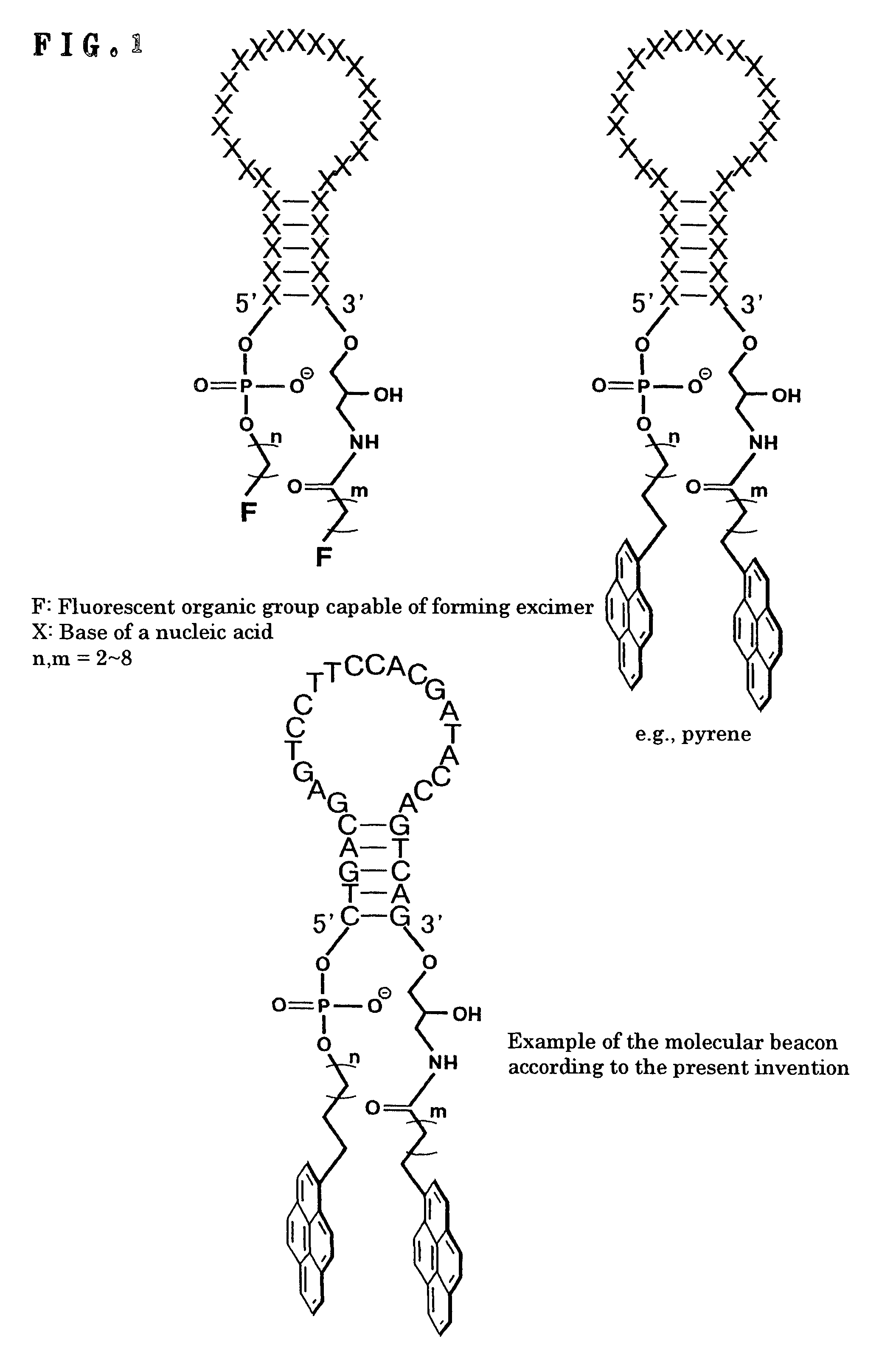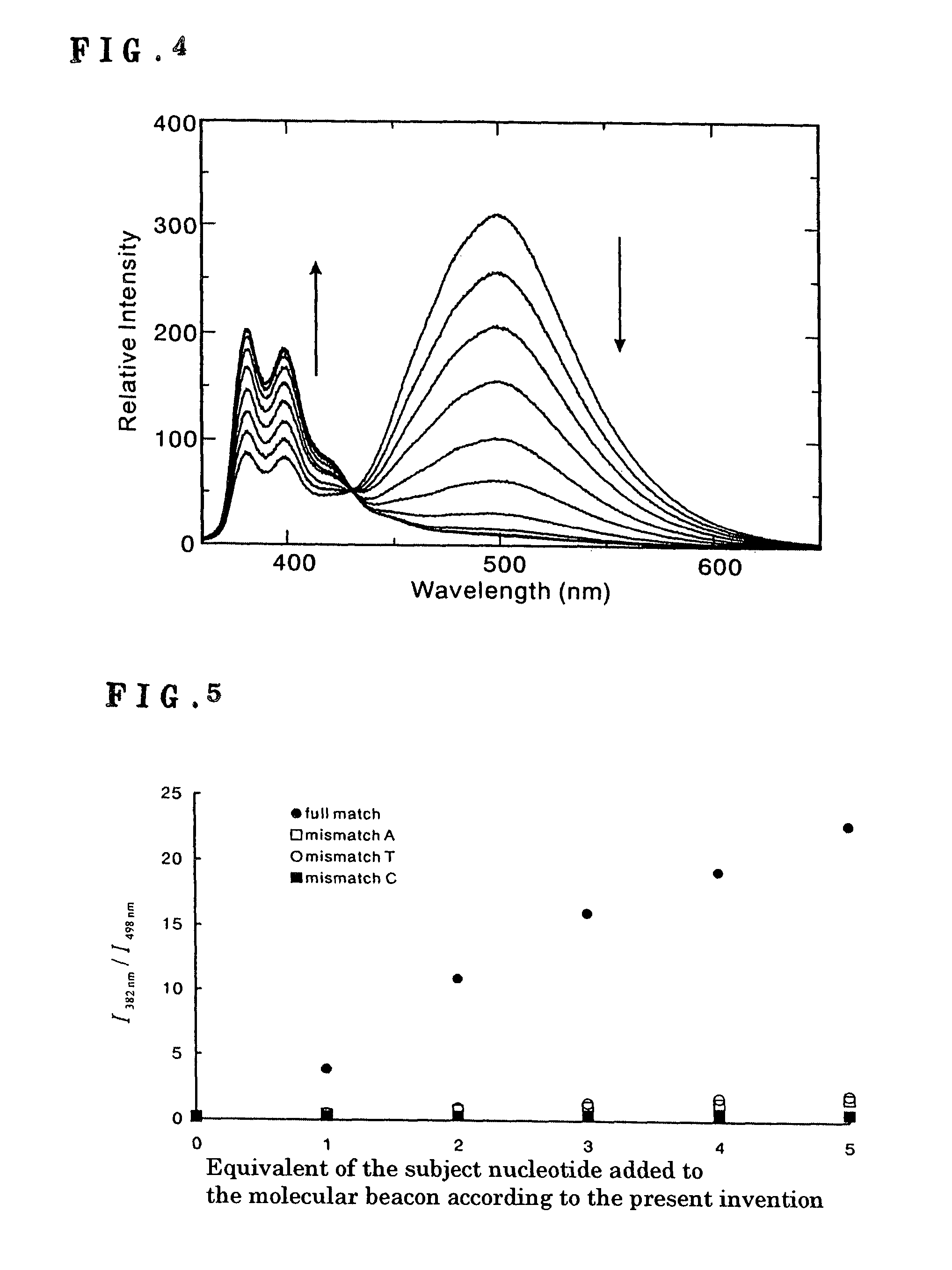DNA detection method using molecular beacon with the use of monomer emission/excimer emission switching of fluorescent molecule
a fluorescent molecule and molecular beacon technology, applied in the field of molecular beacons, can solve the problems of inability to detect unexpected events, weak complex-forming ability, and large loss of entropy, and achieve the effect of elevating accuracy and sensitivity
- Summary
- Abstract
- Description
- Claims
- Application Information
AI Technical Summary
Benefits of technology
Problems solved by technology
Method used
Image
Examples
example 1
[0031]Two kinds of pyrene derivatives were synthesized so that a fluorescent organic group, pyrene, capable of forming an excimer can be covalently bonded to the 5′ and 3′ ends of a single-stranded oligonucleotide having 29 bases. As illustrated in FIG. 2, a phosphoroamidite derivative (1) was synthesized as a derivative for modification of the 5′ end, and a succinimidyl derivative (2) was synthesized as a derivative for modification of the 3′ end with the use of a methyl ester of 3-pyrenylpropionic acid.
[0032]Thus, to a CH3CN (3 ml) solution of 1H-tetrazole (80.7 mg, 1.15 mmol) and 2-cyanoethyl tetraisopropylphosphorodiamidite (463 mg, 1.54 mmol) was added a CH3CN solution (12 ml) of 3-(1-pyrenyl)propanol (200 mg, 0.77 mmol) dropwise at 0° C. After the solution had been stirred at a room temperature for 2 h, the solvent was removed by a rotary evaporator. The residue was poured into NaHCO3 aqueous solution and extracted with ethyl acetate. The ethyl acetate extract was evaporated b...
example 2
[0044]Tm of the molecular beacon containing the synthesized fluorescent organic groups that were covalently bonded thereto was determined according to a usual manner. Thus, electronic absorption spectra were recorded on a V-560 UV / VIS spectrophotometer (JASCO) in a temperature range of from 10 to 90° C. controlled by an ETC-505T Temp. Controller (JASCO) by using a solution containing the molecular beacon (2 μM), 5 mM MgCl2, 50 mM KCl, and 20 mM Tris-HCl (pH 8.0). The Tm value was calculated by a Spectra Manager for Windows DNA Melting Program (JASCO).
[0045]As a result, Tm of the molecular beacon prepared in Example 1 was 59° C., while that of a non-modified oligonucleotide (29-mer) having no pyrene bonded to the ends was 46° C. These results suggested that the two fluorescent organic groups (pyrenes) associated with each other by a hydrophobic interaction functioned as an extra base pair so as to contribute to stabilization of a double strand.
[0046]It was further confirmed that whil...
example 3
[0047]A complementary strand was detected under the following conditions with the use of the same devices as in Example 2. To a 200 nM solution of the molecular beacon synthesized in Example 1 containing 5 mM MgCl2, 50 mM KCl, and 20 mM Tris-HCl (pH 8.0) was added an oligonucleotide consisting of 19 bases complementary to the loop region of the above molecular beacon (0.1 equiv×10) at 25° C. Each mixture was stirred at 25° C. until no more change of the fluorescence spectra occurred (about 15 min). The excitation wavelength was 345 nm, and the fluorescence spectra were recorded from 300 to 650 nm. The excimer emission disappeared and switched to the monomer emission at a stage when almost an equal amount of the oligonucleotide had been added. Since intensity of the monomer emission was not be increased any more by a further addition of the same oligonucleotide beyond the equal amount, the molecular beacon according to the present invention was confirmed to be a very selective DNA pr...
PUM
| Property | Measurement | Unit |
|---|---|---|
| temperature | aaaaa | aaaaa |
| absorption wavelength | aaaaa | aaaaa |
| absorption wavelength | aaaaa | aaaaa |
Abstract
Description
Claims
Application Information
 Login to View More
Login to View More - R&D
- Intellectual Property
- Life Sciences
- Materials
- Tech Scout
- Unparalleled Data Quality
- Higher Quality Content
- 60% Fewer Hallucinations
Browse by: Latest US Patents, China's latest patents, Technical Efficacy Thesaurus, Application Domain, Technology Topic, Popular Technical Reports.
© 2025 PatSnap. All rights reserved.Legal|Privacy policy|Modern Slavery Act Transparency Statement|Sitemap|About US| Contact US: help@patsnap.com



